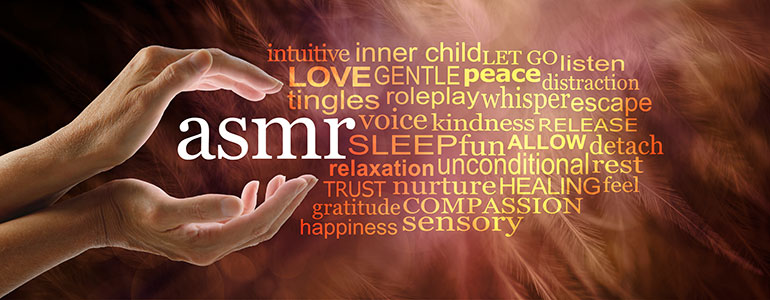wellbeing
What is ASMR? Everything you need to know in 2020
Everything You need to know about ASMR
What is ASMR? It may not have become a household term yet but the phenomenon of ASMR has a huge following online. It stands for autonomous sensory meridian response and commonly refers to the relaxed sensation people feel when they are stimulated by certain triggers. You may have even felt it yourself in everyday life. Have you ever felt a tingly sensation when you were having your haircut? Or during an eye exam when the optician was speaking to you in a gentle whisper? Do you find makeup tutorials soothing? How about Bob Ross the painter? Did you ever feel relaxed when he would dab on his canvas with a brush stroke?

Fans often refer to this sensation as a tingling that runs from the back of the head and down the spine. Some people describe this tingling sensation as a ‘head orgasm’ or ‘braingasm’ and others say they experience a deeply relaxing feeling. Many even credit ASMR for helping them to fall asleep. The trend is thought to have been started online in 2010 by Jennifer Allen, who started a Facebook group to find out more information. She received a huge amount of support from people who felt they finally had a name for the feeling they had long experienced. Nowadays, the most common way to experience autonomous sensory meridian response is through videos online.
What is the point of ASMR and how does it work?
The medical research has been fairly limited but the University of Sheffield and Manchester Metropolitan University did a study in 2018 that looked at the impact ASMR had on the body. They found that people who experienced it showed a bigger reduction in their heart rates when watching ASMR content (an average decrease of 3.14 beats per minute) compared to those who didn’t. Dr Giulia Poerio, of the University of Sheffield’s Department of Psychology said, “Our studies show that ASMR videos do indeed have the relaxing effect anecdotally reported by experiencers – but only in people who experience the feeling.”
Dr Tom Hostler, Lecturer in Psychology at Manchester Metropolitan University, added, “It has been widely anecdotally reported that ASMR helps people to relax, but ours is the first published experiment to show these changes in emotion. We also showed that it wasn’t just watching videos in general that had this effect, as ASMR participants didn’t respond to the ‘control’ videos we showed them in the same way.”
Dr Craig Richard, university professor and researcher hosted a Ted Talk in February 2020 to talk about the impact of ASMR. “The brain regions that are activated while people are watching ASMR videos like these are the same brain regions that are activated when people are receiving positive, personal attention from a kind and caring person in the real world.”
What are some of the most common triggers for ASMR?
Ilse Blansert, a Dutch ASMR artist behind the Waterwhisperers site, said in one video, “Because everyone is different, everybody has different ASMR triggers.” Personal touch is a big trigger for some people but it’s not a necessity. Other ASMR artists claim a trigger can lose its ability over a period of time so what works for a person on one video may not on the next.
What are ASMR sounds and triggers used in ASMR videos are:
– Gentle whispering or soft speaking
– Scratching
– Tapping
– Page turning
– Typing
– Scrunching paper
– Hair brushing (in person or watching hair being brushed)
– Face stroking (in person or watching someone’s skin being brushed)
– Ear stroking or massage
Some ASMR artists even create role play style videos to put their viewers in a familiar and relaxing scenario. For example, a haircut, an eye exam or a facial.
Can anyone experience ASMR?
The simple answer is no. As the science is still lacking, it’s not been proven why some people do not experience asmr and others do. A big reason why some people may have a real aversion to ASMR is due to the disorder misophonia. People who struggle with this disorder are affected negatively by certain sounds, for example breathing, yawning, or chewing. Instead of relaxing a person, they create a fight-or-flight response that triggers anger and a need to escape.
Are there health benefits with ASMR?
While the science is still limited, fans of ASMR regularly flood the comments section of YouTube videos to credit them for easing their anxiety, insomnia, depression and even chronic pain. As more people look towards more natural approaches to achieve general wellbeing, such as exercise, meditation and CBD Oil, ASMR has also been praised for helping people redress the balance and find a sense of inner calm.
On a recent Reddit board, one user explained, “I’ve had anxiety issues my whole life and at certain times will have panic attacks. I’m very thankful to have found the ASMR community. These videos really help me when I need to calm down and relax.” Another added, “This has been the only truly effective thing that I’ve found to combat it, allowing me to climb out of lots of anxiety and panic in order to start improving my life. It’s certainly more helpful than any medication that I’ve been prescribed.”
What does ASMR mean in YouTube?
ASMR videos are very popular online but are most viewed on YouTube. These autonomous sensory meridian response videos usually involved the person, who may refer to themselves as an ASMRtist, recording themselves making sounds and or hand movements on camera. As soft spoken or whispering tends to be a big trigger, the artists will usually speak on camera and maintain eye contact to create a very personal feel with the viewers. As some people dislike the sound of whispering, there are also videos offered without any. The videos can sometimes feature role play to re-enact a scenario in life many of us may find relaxing – like having our hair played with or cut. A slightly kookier trigger is eating, so some ASMRtists film themselves eating a large amount of food in videos known as ‘mukbangs’. Many find it soothing for sleep and anxiety, many videos are centred about this and will focus on positive affirmations and soothing reassurement for viewers who may be struggling.
Who are some popular ASMR artists?
ASMR Darling started creating content back in 2014 and now has 2.42 million subscribers. Gentle Whispering ASMR has around 1.88M subscribers. For UK artists, try WhispersRed who has 886,000 subscribers. The trend for ASMR has definitely seeped into the mainstream. IKEA released a 25 minute ASMR style video back in 2017 as part of the campaign ‘Oddly Ikea’ and to date it has almost 3 million views. W Magazine launched the hugely popular ASMR series on their YouTube channel with celebrities and A list stars such as Jennifer Garner, Kate Hudson and Eva Longoria have taken part, whispering softly into the microphones as they make a series of soothing sounds. Rapper Cardi B’s video proved the most popular with an incredible 39 million hits. Even the Superbowl jumped on the trend with an advert for light beer Pure Gold with Zoe Kravitz, which used isolated and textural sounds to create tingles for the viewers.
Why is ASMR so popular?
The trend is ever growing and people credit the sounds and the movement for reducing anxiety, lifting their mood, helping them sleep and promoting a sense of wellness and relaxation. ASMR may have this impact on more people as the trend continues to grow. In 2019, ASMR ranked as the number one query top in the US and number five top query worldwide. It’s getting around 8.2 million searches per month in the US, and 25.7 million searches worldwide. Now brands are tapping into autonomous sensory meridian response, it’s likely to feature in more advertising and campaigns.
Is ASMR sexual?
Technically speaking, no. Most fans would describe it as sensual, not sexual and intimate, not erotic. Psychologist Mal Harrison, clinical sexologist and founder of the Center for Erotic Intelligence explained, “It’s something pleasurable making its origin in our brains from the pleasure centre. Much the way eating a great dessert may feel.”
Are there any celebrity fans?
Yes! Rapper Cardi B’s hit ASMR video with W Magazine was no fluke as she’s a huge fan of the phenomenon. “My husband thinks it’s very strange and weird that I watch ASMR every single day to go to bed. But it gives me a very tingly sensation.” Cardi’s video used scratching and whispering sounds which which created an amazing response online.
What’s the future of ASMR?
Many people believe the world of virtual reality will help boost the popularity of ASMR. For example, Haptic technology, also known as 3D touch, is the technology that can create a feeling of touch for the user. So, wearing gloves or t-shirts that have haptic technology could allow users to actually feel what the ASMRtist is doing to them in a video. Whether this be a reassuring hand on your shoulder or a hand massage. Live ASMR is also likely to become more popular. In LA, the Whisperlodge is a 90 minute immersive autonomous sensory meridian response experience. And in London, you can get ASMR style facials that involve whispering, soft lighting and stroking.
